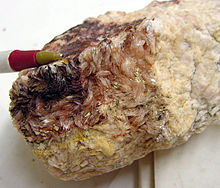Alumstone
| Alunite | |
|---|---|

Alunite from Utah - USGS
|
|
| General | |
| Category | Sulfate minerals |
|
Formula (repeating unit) |
KAl3(SO4)2(OH)6 |
| Strunz classification | 7.BC.10 |
| Crystal system | Trigonal |
| Crystal class | Hexagonal scalenohedral (3m) Space group: (3 2/m) |
| Space group | R3m |
| Unit cell | a = 6.98, c = 17.32 [Å]; Z = 3 |
| Identification | |
| Color | Yellow, red, to reddish brown, colorless if pure; may be white, pale shades of gray |
| Crystal habit | fibrous to columnar, porcelaneous, commonly granular to dense massive |
| Cleavage | On {0001}, perfect |
| Fracture | Conchoidal |
| Tenacity | Brittle |
| Mohs scale hardness | 3.5 – 4 |
| Luster | Vitreous, somewhat pearly on {0001} for crystals, earthy if massive |
| Streak | White |
| Diaphaneity | Transparent to translucent |
| Specific gravity | 2.6 – 2.9 |
| Optical properties | Uniaxial (+) |
| Refractive index | nω = 1.572 nε = 1.592 |
| Birefringence | δ = 0.020 |
| Other characteristics | Strongly pyroelectric |
| References | |
Alunite is a hydrated aluminium potassium sulfate mineral, formula KAl3(SO4)2(OH)6. It was first observed in the 15th century at Tolfa, near Rome, where it is mined for the manufacture of alum. First called aluminilite by J.C. Delamétherie in 1797, this name was contracted by François Beudant three decades later to alunite.
Alunite crystals morphologically are rhombohedra with interfacial angles of 90° 50', causing them to resemble cubes. Crystal symmetry is trigonal. Minute glistening crystals have also been found loose in cavities in altered rhyolite. Alunite varies in color from white to yellow gray. The hardness is 4 and the specific gravity is between 2.6 and 2.8. It is insoluble in water or weak acids, but soluble in sulfuric acid.
Sodium can substitute for potassium in the mineral, and when the sodium content is high, is called natroalunite.
Alunite is an analog of Jarosite, where aluminium replaces Fe3+. Alunite occurs as a secondary mineral on iron sulfate ores.
Alunite occurs as veins and replacement masses in trachyte, rhyolite, and similar potassium rich volcanic rocks. It is formed by the action of sulfuric acid bearing solutions on these rocks during the oxidation and leaching of metal sulfide deposits. Alunite also is found near volcanic fumaroles. The white, finely granular masses closely resemble finely granular limestone, dolomite, anhydrite, and magnesite in appearance. The more compact kinds from Hungary are so hard and tough that they have been used for millstones.
...
Wikipedia
